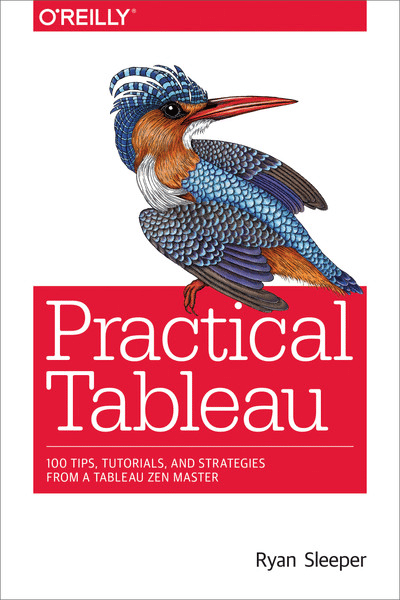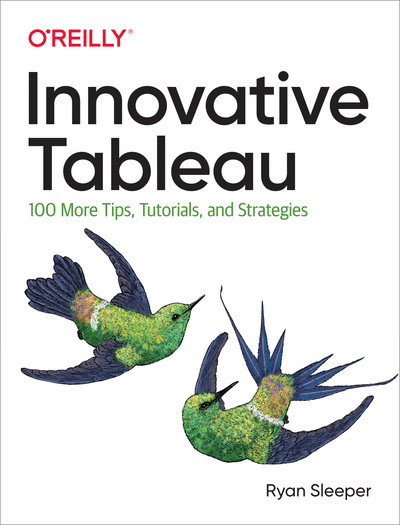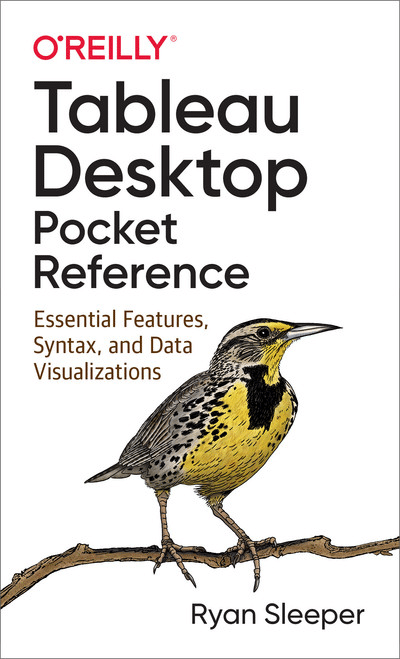
Practical Tableau: 100 Tips, Tutorials, and Strategies from a Tableau Zen Master
Whether you have some experience with Tableau software or are just getting started, this manual goes beyond the basics to help you build compelling, interactive data visualization applications.
About Practical Tableau
Author Ryan Sleeper, one of the world’s most qualified Tableau consultants, complements his web posts and instructional videos with this guide to give you a firm understanding of how to use Tableau to find valuable insights in data.
Over five sections, Sleeper—recognized as a Tableau Zen Master, Tableau Public Visualization of the Year author, and Tableau Iron Viz Champion—provides visualization tips, tutorials, and strategies to help you avoid the pitfalls and take your Tableau knowledge to the next level.
What You’ll Learn
Fundamentals
Get started with Tableau from the beginning
Chart Types
Use step-by-step tutorials to build a variety of charts in Tableau
Tips and Tricks
Learn innovative uses of parameters, color theory, how to make your Tableau workbooks run efficiently, and more
Framework
Explore the INSIGHT framework, a proprietary process for building Tableau dashboards
Storytelling
Learn tangible tactics for storytelling with data, including specific and actionable tips you can implement immediately

Statistical Tableau: How to Use Statistical Models and Decision Science in Tableau
In today’s data-driven world, understanding statistical models is crucial for effective analysis and decision making. Whether you’re a beginner or an experienced user, this book equips you with the foundational knowledge to grasp and implement statistical models within Tableau.
About Statistical Tableau
Gain the confidence to speak fluently about the models you employ, driving adoption of your insights and analysis across your organization. As AI continues to revolutionize industries, possessing the skills to leverage statistical models is no longer optional—it’s a necessity. Stay ahead of the curve and harness the full potential of your data by mastering the ability to interpret and utilize the insights generated by these models.
Whether you’re a data enthusiast, analyst, or business professional, this book empowers you to navigate the ever-evolving landscape of data analytics with confidence and proficiency. Start your journey toward data mastery today.
What You’ll Learn
Fundamentals
The basics of foundational statistical modeling with Tableau
Validate Your Analyses
Learn how to prove your analysis is statistically significant and how to calculate confidence intervals
Best Practices
Learn best practices for incorporating statistics into data visualizations
External Analytics Resources
Use R and Python within Tableau

Innovative Tableau: 100 More Tips, Tutorials, and Strategies
Level up with Tableau to build eye-catching, easy-to-interpret data visualizations.
About Innovative Tableau
In this follow-up guide to Practical Tableau, author Ryan Sleeper takes you through a collection of unique tips and tutorials for using this popular software. Beginning to advanced Tableau users will learn how to go beyond Show Me to make better charts and learn dozens of tricks to improve both the author and user experience.
Featuring many approaches he developed himself, Ryan shows you how to create charts that empower Tableau users to explore, understand, and derive value from their data. He also shares many of his favorite tricks that enabled him to become a Tableau Zen Master, Tableau Public Visualization of the Year author, and Tableau Global Iron Viz Champion.
What You’ll Learn
Fundamentals
Learn what’s new in Tableau since Practical Tableau was released
Chart Types
Examine unique new charts—timelines, custom gauges, and leapfrog charts—plus innovations to traditional charts such as highlight tables, scatter plots, and maps
Tips and Tricks
Get tips that can help make a Tableau developer’s life easier
Framework
Understand what developers can do to make users’ lives easier

Tableau Desktop Pocket Reference
In a crowded field of data visualization and analytics tools, Tableau Desktop has emerged as the clear leader.
About Tableau Desktop Pocket Reference
This is partly due to its ease of use, but once you dive into Tableau’s extensive feature set, you’ll understand just how powerful and flexible this software can be for your business or organization.
With this handy pocket reference, author Ryan Sleeper (Innovative Tableau) shows you how to translate vast amounts of data into useful information. Tableau has done an amazing job of making valuable insights accessible to analysts and executives who would otherwise need to rely on IT. This book quickly guides you through Tableau Desktop’s learning curve.
What You’ll Learn
Fundamentals
How to shape data for use with Tableau Desktop
Chart Types
How to create the most effective chart types
Concepts
Core concepts including discrete versus continuous
Framework
Must-know technical features including filters, parameters, and sets
Analysis
Key syntax for creating the most useful analyses
Dashboards
How to bring it all together with dashboards. And more!

